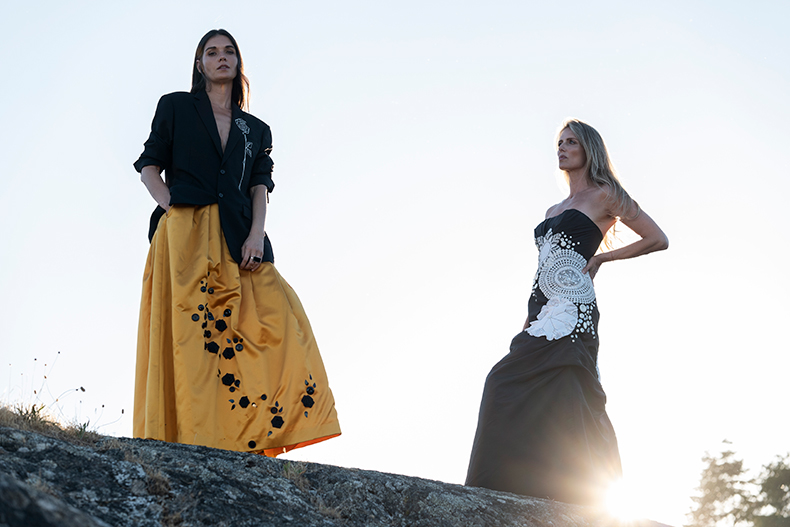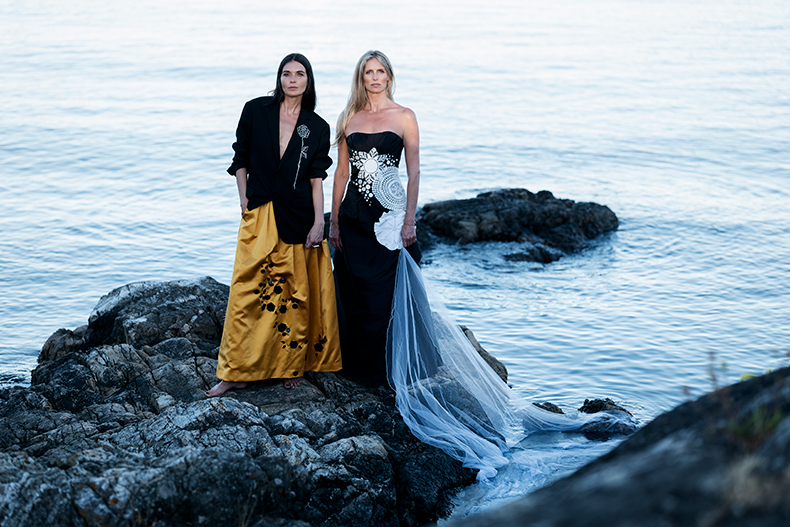Repurposing, visibly mending and creating sustainability in the fashion industry
Words Laura Goldstein
Photography Lia Crowe
When the owners of upscale Victoria consignment fashion boutique House of Savoy filled their storefront window with mounds of used clothing on a recent Earth Day, it wasn’t a ploy for new business.
Rather, it was a not-so-subtle wake-up call for people to rethink tossing away clothing that will end up in a landfill. According to a study carried out by the University of Waterloo in 2023, Canadians dump close to a staggering 500 million kilograms (500,000 tons) of fabric clothing and shoes a year, many of which could be repaired, upcycled or consigned for reuse.
Enter the slow-fashion movement. While fast fashion is characterized by lower-quality, low-priced, mass-produced and machine-made garments, slow-fashion clothing is often handmade, better quality and higher priced; consumers pay more for quality items that last longer.
Other solutions to combat overconsumption and overproduction in the fashion industry include repurposing clothing in vintage and used-clothing stores, and using visible mending techniques to lengthen items’ lives.
Buying repurposed clothing initially started after the First World War, at a time when people had to recycle their clothes due to fabric shortages. How things have changed! But now, with the advent of slow-fashion awareness, people are questioning how clothing and textiles are made, as well as their environmental impacts.
“It’s trendy to buy vintage and consignment today, but we really saw an increase after COVID,” says Émilie Hamel, co-owner of House of Savoy, which is celebrating its 45th anniversary this year. “People wanted to make a bit of extra money and, in many cases, didn’t want to spend a lot for a work-at-home lifestyle.”
“And by consigning clothes, it’s kind of like an exchange: bring something in you’re not wearing anymore, and you get something in return,” adds co-owner Zenija Esmits. “And, when searching for vintage and antique pieces, people are looking for quality and so it’s also an investment.”
Demographics and social media have also changed fashion dictates for what women and men wear today.
“When we were growing up, we might have been influenced by a particular trend or celebrity. But today, young people know about the environment and are more concerned than our generation about where clothing comes from,” Émilie says. “Teens are very into original vintage ‘90s clothing probably made in the US at that time. We’ve had clients as young as 12 years old coming in with their parents to re-sell on consignment. Teens looking for vintage prom dresses is also very popular. We try to keep prices reasonable, and we have a big following of collectors outside of Victoria,” she adds.

With the booming film and television industry in BC, House of Savoy also attracts costumers and scouts for magazine fashion layouts.
On yearly buying trips to Paris and London, the intrepid pair scour thrift stores, charity shops and outdoor antique markets known as brocantes to discover one-of-a-kind treasures that may include Chanel and DIOR for their clients.
Visible mending is another area of slow fashion that the House of Savoy team embraces, noting on their website, “We believe that with a bit of TLC we can inject new life into what may have been an unloved item.” House of Savoy offers an in-house collection that features “thoughtful and fun repairs and embellishments on items.”
You may remember the hippie ’60s when it was groovy to customize your old jeans and jean jackets with embroidery and colourful patches. The idiom “everything old is new again” rings true today more than ever with this growing craft.
“Visible mending is a slow-fashion art form that has its roots in Japanese sashiko, in which colourful embroidery is meant to highlight rips and tears, not cover them up,” explains Amy Walker, who teaches workshops in upcycling clothing with visible mending in Vancouver. Tiny stitches in swirling patterns and contrasting colours emblazon an up-cycled summer dress of Amy’s; her old coverall takes on a new life with the addition of vibrantly patterned patching, and holes in socks are treated to painterly multi-hued darning stitches.
Walker’s Experimending workshop at Vancouver’s Museum of Anthropology (MOA) attracted over 30 hands-on participants of all ages, who each brought a previously worn piece of clothing to embellish. The class was followed by discussions on the historical role of visible mending practiced for centuries by mostly women in almost all cultures.
“If you love a piece of clothing but there’s a tear, no need to toss it out—just get creative and personalize it because it tells a story about you.”
Luxury brands and slow-fashion sustainability awareness don’t have to be mutually exclusive. However, sustainability does need to start from the top with fashion brands taking responsibility directly for sourcing fabrics and manufacturing their garments that in the long run will remain durable.
Senior apparel and textile sustainability strategist Myriam Laroche has carved out a niche career for herself as one of Canada’s most passionate supporters of sustainability and repurposing awareness in the fashion industry. The trailblazer was responsible for bringing 2017’s Eco Fashion Week to Vancouver, where she lived for 11 years. Now back in Quebec City, she recently launched her new agency Collective Détour that assists fashion brands in creating more sustainable futures.
“One of the ideas I worked on for national retailer Simons involved a discussion for a repurposing ‘take-back’ program, but frankly I think each brand should be responsible for its own product recycling with a section on their websites to do so. Value Village has been a client of mine for 12 years and they actually pay not-for-profits by the pound for their clothes. That’s the investment they make to ensure that clothing and textiles don’t end up in a landfill,” says Myriam, also noting that the thrift store icon has opened Value Village Boutique on South Granville in Vancouver; it features two floors of repurposed designer and vintage fashions purchased through Big Brothers Big Sisters of Canada.
Slow fashion is also being embraced by Canadian designers like Vancouver-based Jason Matlo and Evan Ducharme, “who concentrate on creating smaller bespoke collections in response to fast fashion,” Myriam says.
International awareness to cut textile waste is gaining traction. France is introducing discounts for repurposing clothing to customers through subsidies to tailors, clothing brands and repair shops who join the free eco-initiative, Refashion.
And as the slow-fashion movement gains traction, creative ideas are also gaining momentum. Imagine travelling to Japan without a suitcase, travelling in just the clothes you are wearing. Japan Airlines offers an innovative fashion option—renting your vacation clothes! Rental of pre-owned and end-of-stock apparel, including cleaning, can be reserved ahead on the website Any Wear, Anywhere, and then delivered to your hotel. Undergoing a one-year trial, the airline hopes rentals will cut down on carbon emissions from aircraft by reducing the weight of luggage and increase sustainable tourism.
The fashion is “slow,” but the ideas are coming in fast.


 Secrets and lives — and the 7 sins with Michelle Webber
Secrets and lives — and the 7 sins with Michelle Webber